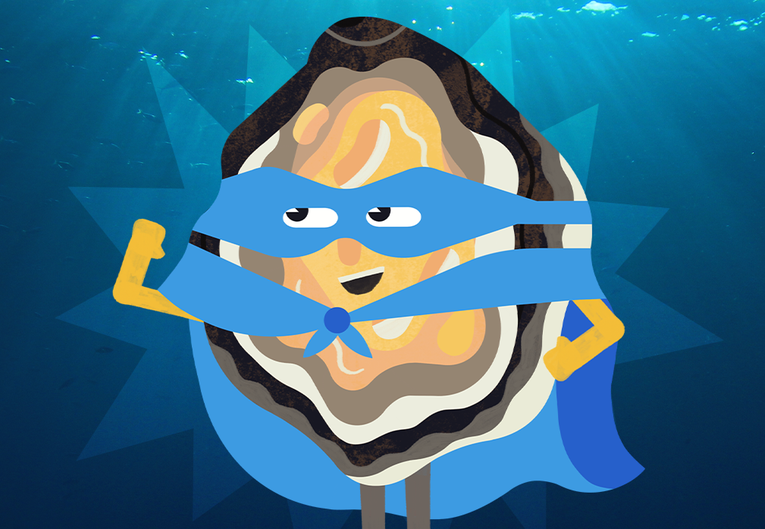
Restoration Forth
In the Firth of Forth, an area the size of modern-day Edinburgh was once covered by European flat oyster beds, but by the early 1900s they were all fished out. Together with project partners, (including science lead Heriot-Watt University) and local community members, we’re working to restore European flat oysters in the area.
About the project
Restoration Forth is a community-inspired marine restoration project that aims to reintroduce 40,000 European flat oysters and restore seagrass meadows to the Firth of Forth, Scotland.
Working with local communities, the Restoration Forth project team has been researching potential sites and trialling methods for restoring both oysters and seagrass to the area. Since the project began in 2022, the team have now introduced a baseline population of oysters, which we hope will become self-sustaining over time.
Together, communities around the Firth of Forth and across Scotland can help restore our marine environment and influence Scottish Government policy for stronger marine protection. The Restoration Forth team is engaging with local communities throughout the project, empowering them to get involved through education, training, and volunteering opportunities.
The vision of the project is for species and habitat restoration to be trialled around the Forth, involving local communities at each step of the process.
Calum Duncan, Head of Policy and Advocacy
Our partnership with Heriot-Watt University builds on our successful, ongoing collaboration as part of the award-winning Dornoch Environmental Enhancement Project (DEEP) which has so far reintroduced 100,000 European flat oysters to the Dornoch Firth.
Why oysters?
As well as historically supporting local communities, European flat oysters provide a wealth of ecosystem services. Not only do they enhance biodiversity and create nursery habitats, they also improve water quality by filtering up to 200 litres of water a day and contribute to the stabilisation of carbon in the marine environment.
Globally, European flat oysters have declined by around 85%. Restoration Forth aims to restore and conserve this vital species by reintroducing oysters to the Firth of Forth, where they will enhance the local ecosystem.

Credit: Blaise Bullimore
This unsung hero needs your help
Why seagrass
Like oysters, seagrass meadows provide many ecosystem services. They enhance water quality through filtration, help protect coastlines from erosion and store carbon through their root systems. We’re supporting project partners to restore seagrass in the Firth of Forth.
Find out more about seagrass and the Marine Conservation Society's seagrass restoration work across the rest of the UK.
Help restore the Firth of Forth
There are lots of opportunities to get involved in the project and you can keep up-to-date with our upcoming events on the Restoration Forth website.
Recently, the team have launched a brand-new citizen science guide. Citizen science is when the public join forces with scientific teams to collaborate on research projects.
Anyone can be a citizen scientist and it’s a great way to get involved in scientific projects, get outside and meet new people.
The Restoration Forth science team at Heriot-Watt University has identified three key types of information that are valuable for assessing the survival and wider benefit of returning oysters to the Firth of Forth:
- Finding the best places to restore oysters
- Checking how the oysters are doing
- Tracking the benefits of returning oysters
Read the full report on the development of citizen science surveys for the project.
Get involved
Meet the team
Caitlin Godfrey, Community Engagement Lead
Caitlin is managing the community engagement for the project, finding ways to involve local people in practical restoration, advocacy and citizen science activities. She works with Anna and the rest of the engagement team to deliver a range of free events around the area.

Anna Inman, Shellfish Engagement Officer
Anna is working with communities around the Firth of Forth, delivering events and activities related to oysters and their restoration with Caitlin and the Heriot-Watt University team.

Credit: Anna Inman
Emmy Cooper-Young, Shellfish Restoration Officer
Emmy has recently finished in her role on Restoration Forth and completed her Master of Research at Heriot-Watt University, which focused on developing a European flat oyster restoration plan for the Firth of Forth, scoping out suitable areas for oysters to be returned to. Her research will help to inform future oyster restoration in this area.

Credit: Professor William Sanderson
Other shore activities
If you’re interested in more ways to contribute to marine projects, here are some other great citizen science projects you can get involved in.
A deeper dive into the science
Restoration Forth has a brilliant team of scientists who are researching lots of different elements of returning oysters and the impacts they have on marine environments.
The Marine Conservation Society are part of this WWF-led project, alongside The Ecology Centre, Edinburgh Shoreline, Fife Coast & Countryside Trust, Heart of Newhaven, Heriot-Watt University, Project Seagrass, Royal Botanic Garden Edinburgh and Scottish Seabird Centre.
The first phase of Restoration Forth (2022-24) was made possible by funding from Aviva, the Moondance Foundation, the ScottishPower Foundation and the Scottish Government’s Nature Restoration Fund, facilitated by the Scottish Marine Environmental Enhancement Fund, and managed by NatureScot.
The current phase of Restoration Forth is made possible by funding from Sky and the Cinven Foundation; the project is supported by the Scottish Government’s Nature Restoration Fund, managed by NatureScot.



